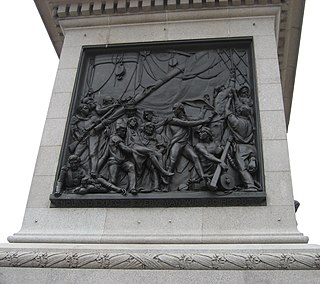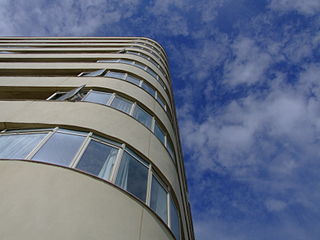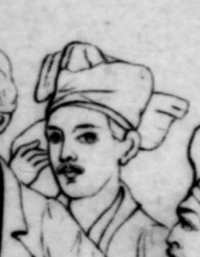
Joseph Henry Good (1775-1857) was an English architect who was clerk of works at the Tower of London, Royal Mint, Kensington Palace and the Royal Pavilion Brighton.

Joseph Henry Good (1775-1857) was an English architect who was clerk of works at the Tower of London, Royal Mint, Kensington Palace and the Royal Pavilion Brighton.
Good was born in 1775, the son of the Reverend Joseph Good, a Somerset clergyman. [1]
Good was a pupil of Sir John Soane from 1795 to 1799. He became clerk of works at the Tower of London, Royal Mint, Kensington Palace and the Royal Pavilion Brighton, [2] and designed Armourers' Hall in Coleman Street, London (1839–41). [1]
Good died on 20 November 1857. He is buried at Kensal Green Cemetery. [2]
Kensal Green is an area in north-west London. It lies mainly in the London borough of Brent, with a small part to the south within Kensington and Chelsea. Kensal Green is located on the Harrow Road, about 4.4 miles (7.1 km) miles from Charing Cross.

The Royal Borough of Kensington and Chelsea is an Inner London borough with royal status. It is the smallest borough in London and the second smallest district in England; it is one of the most densely populated administrative regions in the United Kingdom. It includes affluent areas such as Notting Hill, Kensington, South Kensington, Chelsea, and Knightsbridge.

Notting Hill is a district of West London, England, in the Royal Borough of Kensington and Chelsea. Notting Hill is known for being a cosmopolitan and multicultural neighbourhood, hosting the annual Notting Hill Carnival and Portobello Road Market. From around 1870, Notting Hill had an association with artists.

Kensal Green Cemetery is a cemetery in the Kensal Green area of North Kensington in the Royal Borough of Kensington and Chelsea in London, England. Inspired by Père Lachaise Cemetery in Paris, it was founded by the barrister George Frederick Carden. The cemetery opened in 1833 and comprises 72 acres (29 ha) of grounds, including two conservation areas, adjoining a canal. The cemetery is home to at least 33 species of bird and other wildlife. This distinctive cemetery has memorials ranging from large mausoleums housing the rich and famous to many distinctive smaller graves and includes special areas dedicated to the very young. It has three chapels and serves all faiths. It is one of the Magnificent Seven cemeteries in London.

Robert Smirke was an English painter and illustrator, specialising in small paintings showing subjects taken from literature. He was a member of the Royal Academy.

Joseph d'Aguilar Samuda was an English engineer and politician. He was born in London the younger son of Abraham Samuda, and brother of Jacob Samuda. He started out in his father's counting-house, but in 1832 he joined his elder brother to set up Samuda Brothers.

Thomas Allom was an English architect, artist, and topographical illustrator. He was a founding member of what became the Royal Institute of British Architects (RIBA). He designed many buildings in London, including the Church of St Peter's and parts of the elegant Ladbroke Estate in Notting Hill. He also worked with Sir Charles Barry on numerous projects, most notably the Houses of Parliament, and is also known for his numerous topographical works, such as Constantinople and the Scenery of the Seven Churches of Asia Minor, published in 1838, and China Illustrated, published in 1845.

John Edward Carew was a notable Irish sculptor during the 19th century. His most prominent work is The Death of Nelson, one of the four bronze panels on the pedestal of Nelson's Column in Trafalgar Square.

John Thomas (1813–1862) was a British sculptor and architect, who worked on Buckingham Palace and the Palace of Westminster.

Kensal Town is a residential sub-district of Kensal Green in north-west London. It is located at the northern tip of the Royal Borough of Kensington and Chelsea where it meets the City of Westminster. Although local residents generally consider the area to be North Kensington, it is officially and historically an area of Kensal Green. It is included in the W postcode area and was first recorded in 1876 as Kensal New Town. This name had been used since the 1840s to distinguish the area south of the Harrow Road, in between the Grand Union Canal and the Great Western Main Line, where new housing was largely occupied by Irish immigrants. By the late 19th century the area had deteriorated into a run-down slum, though it was much improved when the slums were cleared and replaced with new council housing during the mid-20th century.

Roger Morris was an English architect whose connection with Colen Campbell brought him to the attention of Henry Herbert, 9th Earl of Pembroke, with whom Morris collaborated on a long series of projects.

Brighton and Hove City Centre is the commercial and cultural centre of the city of Brighton. Geographically, the so-called city centre is located in an easterly part of the Brighton and Hove urban conurbation.
John Vardy was an English architect attached to the Royal Office of Works from 1736. He was a close follower of the neo-Palladian architect William Kent.

Charles Vacher (1818–1883) was a British painter in watercolours.

Joseph Durham was an English sculptor.

James William Wild was a British architect. Initially working in the Gothic style, he later employed round-arched forms. He spent several years in Egypt. He acted as decorative architect to the Great Exhibition of 1851, and designed the Grimsby Dock Tower, completed in 1852. After a considerable break in his career he worked on designs for the South Kensington Museum, and designed the British embassy in Tehran. He was curator of the Sir John Soane's Museum from 1878 until his death in 1892.
George Frederick Carden was an English barrister, magazine editor and businessman, credited with the development of the garden cemetery movement in Britain and the foundation of London's pioneering example: Kensal Green Cemetery.

Maxwell and Tuke was an architectural practice in Northwest England, founded in 1857 by James Maxwell in Bury. In 1865 Maxwell was joined in the practice by Charles Tuke, who became a partner two years later. The practice moved its main office to Manchester in 1884. Frank, son of James Maxwell, joined the practice in the later 1880s and became a partner. The two senior partners both died in 1893, and Frank Maxwell continued the practice, maintaining its name as Maxwell and Tuke.

Sir John Dean Paul, 1st Baronet, of Rodborough, was an English landowner, banker, painter, and occasional author.